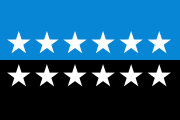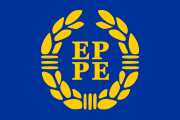Flag of Europe
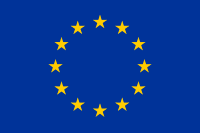 |
|
| Use | National flag and state and naval ensign. |
| Proportion | 2:3 |
| Adopted | 8 December 1955 (CoE) 26 May 1986 (EU) |
| Design | A circle of 12 5-pointed gold stars on a blue field. |
| Designed by | Arsène Heitz and Paul Lévy |
The Flag of Europe is the flag and emblem of the European Union (EU) and Council of Europe (CoE).[1] It consists of a circle of 12 golden (yellow) stars on a blue background. It was created in 1955 by the CoE and adopted by the EU, then the European Economic Community (EEC), in the 1980s.
The CoE and EU are distinct in membership and nature. The CoE is a 47-member international organisation dealing with human rights, democracy and the rule of law, while the EU is a quasi-federal union of 27 states focused on economic integration and political cooperation. Today, the flag is mostly associated with the latter.
It was the intention of the CoE that the flag should come to represent Europe as a whole, and since its adoption the membership of the CoE covers nearly the entire continent. This is why the EU adopted the same flag. The flag has been used to represent Europe in sporting events and as a pro-democracy banner outside the Union.
Contents |
Design
The flag is rectangular with 2:3 proportions: its fly (width) is one and a half times the length of its hoist (height). Twelve gold (or yellow) stars are centred in a circle (the radius of which a third of the length of the hoist) upon a blue background All the stars are upright (one point straight up), have five points and are spaced equally according to the hour positions on the face of a clock.[2]
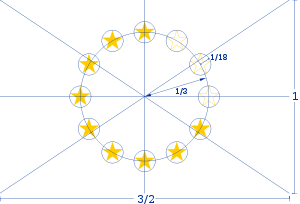
The heraldic description given by the EU is: "On an azure field a circle of twelve golden mullets, their points not touching."[3] The Council of Europe gives the flag a symbolic description in the following terms;
Against the blue sky of the Western world, the stars represent the peoples of Europe in a circle, a symbol of unity. Their number shall be invariably set at twelve, the symbol of completeness and perfection ... just like the twelve signs of the zodiac represent the whole universe, the twelve gold stars stand for all peoples of Europe – including those who cannot as yet take part in building up Europe in unity and peace.
Colours
| RGB | Hex | PMS | CMYK | |
|---|---|---|---|---|
| Blue | 0/51/153 |
003399 |
Reflex Blue | 100% Process Cyan; 80% Process Magenta |
| Gold | 255/204/0 |
FFCC00 |
Yellow | Process Yellow |
The base colour of the flag is a dark blue (Reflex Blue, a mix of Cyan and Magenta), while the golden stars are portrayed in Yellow. The colours are regulated according to the Pantone colouring system (see table to the right for specifications).
Some claim that there was an early design of white stars on a light blue field, as a gesture to the peace and internationalism of the United Nations[4] while an official website makes a reference to blue and gold being the original colours of Count Richard Nikolaus von Coudenhove-Kalergi who proposed a Pan European Union in 1923 and was an active proponent of the early Community (see International Paneuropean Union).[5]
Number of stars

The number of stars on the flag is fixed at 12 and is not related to the number of member states of the EU since it is originally the flag of the Council of Europe and does not have a relationship with the EU.[6] In 1953, the Council of Europe had 15 members; it was proposed that the future flag should have one star for each member, and would not change based on future members. West Germany objected to this as one of the members was the disputed area of Saarland, and to have its own star would imply sovereignty for the region.
On this basis, France also objected to fourteen stars, as this would imply the absorption of Saarland into Germany. Myth has it that the Italian representative then objected that thirteen was an unlucky number (it is not unlucky in Italy), as well as the fact that early flags of the United States featured that number of stars. Twelve was eventually adopted as a number with no political connotations and as a symbol of perfection and completeness[6] because of the ubiquity of the number for groups in European cultures and traditions such as:
|
|
Biblical interpretation
The circle of stars bears a striking similarity to the twelve-star halo of the Virgin Mary seen in Roman Catholic art. The flag's designer, Arsène Heitz, has acknowledged that the Book of Revelation (which is where the twelve-star halo of the Virgin Mary was first mentioned) helped to inspire him.[7] Revelation 12:1 is cited to explain the symbolism: "A great sign appeared in heaven, a woman clothed with the sun, and the moon under her feet, and on her head a crown of twelve stars" (a crown of stars can be interpreted as a "Crown of Immortality").
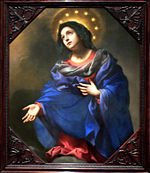
Others have traced the origin of the flag of Europe to the time of the Second World War. Paul Lévy, a Belgian of Jewish descent, vowed that he if he should survive the war, he would convert to Christianity. He duly survived and became a Catholic. When the Council of Europe was established, Lévy became its Chief of its Department of Culture. In 1952, when the idea of a European flag was being discussed, Lévy backed the flag of the Pan Europe Movement. However, the cross element in its design was rejected by the Socialists and Turks as too Christian. It is claimed that one day, Lévy passed a statue of the Virgin Mary with a halo of stars and was struck by the way the stars, reflecting the sun, glowed against the blue of the sky. Lévy later visited Count Benvenuti, a Venetian Christian democrat and then Secretary General of the Council of Europe, and suggested that he should propose twelve golden stars on a blue ground as motif for the flag of Europe.[8] However, the idea of the flag's design came from Arsène Heitz, not Lévy, and Lévy has stated that he was only informed of the connection to the Book of Revelation after it was chosen.[9] Official authorities of the European Union disregard the biblical interpretation as myth.[10]
Usage
Council of Europe
The flag was originally designed by the Council of Europe,[11] and as such the CoE holds the copyright for the flag. However the Council of Europe agreed that the European Communities could use the flag and it had promoted its use by other regional organisations since it was created. The Council of Europe now shares responsibility with the European Commission for ensuring that use of the symbol respects the dignity of the flag - taking measures to prevent misuse of it.[11]
Besides using the flag, the Council also uses a defaced version of the flag as its emblem: it is the existing design with a stylised, green "e" over the stars.[11]
European Union
The flag symbolises the EU as a whole but it is also the sole emblem of the European Commission, the EU's executive arm.[6] However all other bodies and agencies, except for the European Agency for Reconstruction, have their own emblem, albeit often inspired by the flag's design and colours.[12]
As part of the EU's usage, the flag appears on driving licences and vehicle registration plates issued in the Union[13] as well as on the euro banknotes.[14] Euro coins also display the twelve stars of the flag on both the national and common sides.[15]
Protocol

It is mandatory for the flag to be used in every official speech made by the President-in-Office of the European Council and is often used at official meetings between the leaders of an EU state and an non-EU state (where there is the flag of the third country, the national flag and European flag appear together). Some members also have their own rules regarding the use of the flag alongside their national flag on domestic occasions, for example the obligatory use alongside national flags outside police stations or local government buildings. Outside official use, the flag may not be used for aims incompatible with European values.[13]
In national usage, national protocol usually demands the national flag takes precedence over the European flag (which is usually displayed to the right of the national flag from the observer's perspective). On occasions where the European flag is flown alongside all national flags (for example, at a European Council meeting, the national flags are placed in alphabetical order (according to their name in the main language of that state) with the European flag either at the head, or the far right, of the order of flags.[16][17]
Extraordinary flying of the flag is common on the EU's flag day, known as Europe Day which is celebrated annually on 9 May.[18][19][20] On Europa Day 2008, the flag was flown for the first time above the German Reichstag.[21]
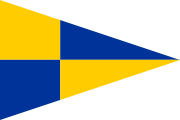
In addition to the flags use by the government and people, the flag is also used in EU military operations,[22] however it is not used as a civil ensign. In 2003, an MEP tabled a proposal in a temporary committee of the European Parliament that national civil ensigns be defaced with the European flag. This proposal was rejected by Parliament in 2004 and hence the European flag is not used as a European civil ensign.[23]
Despite not having a civil ensign, the EU's Fishery Inspection teams display a blue and yellow pennant. The pennant is flown by inspection vessels in EU waters. The flag is triangular and quartered blue and yellow and was adopted according to EEC Regulation #1382/87 on 20 May 1978.[24] There are no other variants or alternative flags used by the EU (in contrast to countries which have presidential, naval and military variants).
Wider use
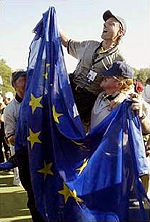
The flag has been intended to represent Europe in its wider sense. The Council of Europe covers all but three European countries, thereby representing much of Europe.[11]
In particular the flag has become a banner for pro-Europeanism outside the Union, for example in Georgia where the flag is on most government buildings since the coming to power of Mikhail Saakashvili,[25] who used it during his inauguration[26] stating: "[the European] flag is Georgia’s flag as well, as far as it embodies our civilisation, our culture, the essence of our history and perspective, and our vision for the future of Georgia."[27] It was later used in 2008 by pro-western Serbian voters ahead of an election.[28]
It is also used as a pro-democracy emblem in countries such as Belarus where it has been used on protest marches alongside the banned former national flag and flags of opposition movements.[29][30] The flag was used widely in a 2007 "European March" in Minsk as protesters rallied in support of democracy and accession to the EU.[31]
The flag is also used in certain sports arrangements where a unified 'Team Europe' is represented, in contrast to the more nationalistic tone of other sporting events. Following the 2004 Summer Olympics, President Romano Prodi pointed out that the combined medal total of the European Union was far greater than that of any other country and called for EU athletes to fly the European flag at the following games along side their own as a sign of solidarity (which did not happen).[32]
The flag, or features of it, are often used in the logos of organisations of companies which stress a pan-European element, for example European lobbyist groups or transnational shipping companies.
History
Previous flags
- Further information: Flag of the European Coal and Steel Community
Prior to development of political institutions, flags representing Europe were limited to unification movements. The most popular were the European Movement's large green 'E' on a white background, and the "Pan European Flag" (see "Creation" below).[33] With the development of institutions, aside from the Council of Europe, came other emblems and flags. None were intended to represent wider Europe and have since been replaced by the current flag of Europe.
The first major organisation to adopt one was the European Coal and Steel Community (ECSC), which merged into the European Communities. The ECSC was created in 1952 and the flag of the ECSC was unveiled in 1958 Expo in Brussels.[5]
The flag had two stripes, blue at the top, black at the bottom with 6 gold (silver after 1973) stars, 3 on each stripe. Blue was for steel, black for coal and the stars were the six member-states. The stars increased with the members until 1986 when they were fixed at 12. When the ECSC treaty expired in 2002, the flag was lowered outside the European Commission in Brussels and replaced with the European flag.[5][34][35]
The European Parliament also used its own flag from 1973, but never formally adopted it. It fell out of use with the adoption of the twelve star flag by the Parliament in 1983. The flag followed the yellow and blue colour scheme however instead of 12 stars there were the letters EP and PE (initials of the European Parliament in the then six community languages) surrounded by wreath.[36]
Creation
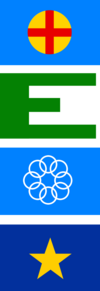
The Council of Europe's search for a symbol began in 1950 when it set up a committee to look into the question of a European flag. There were numerous proposals but a clear theme for stars and circles emerged.[9] Count Richard Nikolaus von Coudenhove-Kalergi proposed that they adopt the flag of his International Paneuropean Union, which was a blue, with a red cross inside an orange circle at the centre, which he had himself recently adopted for the European Parliamentary Union.[37] Due to the cross symbolism, this was rejected by Turkey (a member of the Council of Europe since 1949).[4] Kalergi then suggested adding a crescent to the cross design, to overcome the Muslim objections.[38] Another organisation's flag was the European Movement, which had a large green E on a white background.[39][40] A further design was one based on the Olympic rings; eight silver rings on a blue background. It was rejected due to the rings' similarity with "dial","chain" and "zeros". A proposal by Carl Weidl Raymon was of a large yellow star on a blue background. However it was rejected due to its similarity with the so-called Burnet flag, which had been briefly adopted in the 1830s by the Republic of Texas, and the flag of the Belgian Congo.[4]
The Consultative Assembly narrowed their choice to two designs. These was one by Salvador de Madariaga, who was the founder of the College of Europe who suggested a constellation of stars on a blue background and another by Arsène Heitz,[33] who worked at the Council's postal service and had submitted dozens of designs,[41] that was a circle of stars in the present form.[33] The Consultative Assembly favoured Heitz's design, however the flag the Assembly chose had fifteen stars, reflecting the number of states of the Council of Europe, rather than twelve. The Consultative Assembly chose this flag and recommended that the Council adopt it.[42]
The Committee of Ministers (the Council's main decision making body) agreed with the Assembly that the flag should be a circle of stars, but the number thirteen was a source of contention (see "Number of stars" above).[9] The number twelve was chosen and Paul M. G. Lévy drew up the exact design of the new flag as it is today.[9] The Parliamentary Assembly of the Council of Europe approved it on 25 October 1955. Adopted on 8 December 1955, it was unveiled at the Château de la Muette in Paris on 13 December 1955.[33][11]
European Communities

Following the 1958 Expo '58 in Brussels, the flag caught on and the Council of Europe lobbied for other European organisations to adopt the flag as a sign of European unity.[33] The European Parliament took the initiative in seeking a flag to be adopted by the European Communities. Shortly after the first direct elections in 1979 a draft resolution was put forward on the issue. The resolution proposed that the Communities' flag should be that of the Council of Europe[11] and it was adopted by the Parliament on 1983-04-11.[33]
The June 1984 European Council (The Communities' leaders) summit in Fontainebleau stressed the importance of promoting a European image and identity to citizens and the world. The following year, meeting in Milan, the European Council approved a proposal from the Committee on a People’s Europe (Adonnino Committee) that a flag should be adopted. Following the permission of the Council of Europe,[11] the European Council formally adopted the flag on behalf of the whole Community on 1986-05-26.[33] The European Union, which was established by the Maastricht Treaty in 1992 to replace the EC and encompass its functions, also adopted the flag. Since then the use of the flag has been controlled jointly by the Council of Europe and the European Union.[11]
Recent events
| “ | Belgium, Bulgaria, Germany, Greece, Spain, Italy, Cyprus, Lithuania, Luxemburg, Hungary, Malta, Austria, Portugal, Romania, Slovenia and the Slovak Republic declare that the flag with a circle of twelve golden stars on a blue background, the anthem based on the ‘Ode to Joy’ from the Ninth Symphony by Ludwig van Beethoven, the motto ‘United in diversity’, the euro as the currency of the European Union and Europe Day on 9 May will for them continue as symbols to express the sense of community of the people in the European Union and their allegiance to it. | ” |
|
—Final Act, Official Journal of the European Union, 2007 C 306-2 [43] |
||
The flag was to have been given a formal status in the proposed European Constitution. However since the ratification of that failed, the leaders removed the state-like elements such as the flag from the replacement Treaty of Lisbon. The European Parliament however had supported the inclusion of symbols and in response backed a proposal to use the symbols such as the flag more often in the Parliament with Jo Leinen MEP suggesting that the Parliament should again take the avant-garde in their use.[44] Later, in September 2008, Parliament's Committee on Constitutional Affairs proposed a formal change in the institution's rules of procedure to make better use of the symbols. Specifically, the flag would be present in all meeting rooms (not just the hemicycle) and at all official events.[45] The proposal was passed on 8 October 2008 by 503 votes to 96 (15 abstentions).[46]
Additionally, a declaration by sixteen Member States on the symbols, including the flag, was included in the final act of the Treaty of Lisbon stating that the flag, the anthem, the motto and the currency and Europe Day "will for them continue as symbols to express the sense of community of the people in the European Union and their allegiance to it."[43]
In April 2004, the flag was flown in space for the first time by ESA astronaut André Kuipers while on board the International Space Station.[47]
Barcode flag
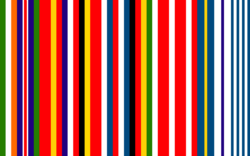
- Further information: Rem Koolhaas#European Flag proposal
In 2002, Dutch architect Rem Koolhaas and his architecture firm Office for Metropolitan Architecture (OMA) designed a new flag in response to Commission President Romano Prodi's request to find ways of rebranding the Union in a way that represents Europe's "diversity and unity". The proposed new design was dubbed the "barcode" as it displays the colours of every European flag (of the then 15 members) as vertical stripes. As well as the barcode comparison, it had been compared unfavourably to wallpaper, a TV test card and deckchair fabric. Unlike the current flag it would change to reflect the member states.[48]
It was never officially adopted by the EU or any organisation; however, it was used as the logo of the Austrian EU Presidency in 2006. It had been updated with the colours of the 10 members who had joined since the proposal and was designed by Koolhaas's firm. Its described aim is "to portray Europe as the common effort of different nations, with each retaining its own unique cultural identity".[49] There were initially some complaints, as the stripes of the flag of Estonia were displayed incorrectly.
Derivative designs

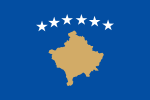
The design of the European flag has been used in a variation, such as that of the Council of Europe mentioned above, and also to a greater extent such as the flag of the Western European Union (WEU), which uses the same colours and the stars but has a number of stars based on membership and in a semicircle rather than a circle. It is also defaced with the initials of the Western European Union in two languages.[50]
The flag of Bosnia and Herzegovina does not have such a strong connection as the WEU flag, but was partly inspired by the European involvement in, and aspirations of, Bosnia and Herzegovina. It uses the same blue and yellow colours and the stars, although of a different number and colour, are a direct reference to those of the European flag.[51]
Likewise, Kosovo uses blue, yellow and stars in its flag in reference to the European flag, symbolising its European ambitions (membership of the European Union). Kosovo has, like Bosnia and Herzegovina, seen heavy European involvement in its affairs, with the European Union assuming a supervisory role after its declared independence in 2008.[52][53]
See also
- Symbols of Europe
- Circle of stars
- Flag of the European Coal and Steel Community
- Flag of the Western European Union
References
- ↑ It is termed "Flag of Europe" or "European Flag" by both organisations, intended to represent the continent as a whole, but has no legal basis beyond use by the CoE, which represents nearly the entire of Europe. It is also known as the "Flag of the European Union" excluding its relation to the CoE but the term "Flag of the Council of Europe" is never used.
- ↑ "Graphical specifications for the European flag". Council of Europe. Retrieved on 2008-07-26.
- ↑ "Graphical specifications for the European Emblem". Europa (web portal). Retrieved on 2007-08-04.
- ↑ 4.0 4.1 4.2 Council of Europe fahnenversand.de
- ↑ 5.0 5.1 5.2 "Do the Number of Stars on the European Flag Represent the Member States?". European Commission's delegation to Ukraine. Retrieved on 2008-07-11.
- ↑ 6.0 6.1 6.2 "The European Flag". Europa (web portal). Retrieved on 2007-08-04.
- ↑ "The European Commission and religious values". The Economist (2004-10-28). Retrieved on 2007-08-04.
- ↑ The Flag and State Encyclopaedia
- ↑ 9.0 9.1 9.2 9.3 "Account by Paul M. G. Lévy on the creation of the European flag". European NAvigator. Retrieved on 2008-07-15.
- ↑ "European Union: Myths on the flag". Flags Of The World (2007-02-04). Retrieved on 2007-08-04.
- ↑ 11.0 11.1 11.2 11.3 11.4 11.5 11.6 11.7 "Council of Europe's Emblems". Council of Europe. Retrieved on 2007-08-16.
- ↑ "Emblems". Europa (web portal). Retrieved on 2007-12-28.
- ↑ 13.0 13.1 "European Union: Legal use of the flag". Flags Of The World (2004-10-28). Retrieved on 2007-08-04.
- ↑ "The euro". European Central Bank. Retrieved on 2007-08-04.
- ↑ "Euro coins". European Central Bank. Retrieved on 2007-12-28.
- ↑ "An Bhratach Náisiúnta / The National Flag" (RTF). Department of the Taoiseach. Retrieved on 2007-12-28.
- ↑ "A Guide to Flag Protocol in the United Kingdom" (PDF). Flag Institute. Retrieved on 2007-12-28.
- ↑ Rasmussen, Rina Valeur. "Celebration of Europe Day 9 May 2007 in Denmar". politeia. Retrieved on 2007-08-04.
- ↑ "Photo from Reuters Pictures". Reuters Images, on Daylife. Retrieved on 2008-05-09.
- ↑ Rasmussen, Rina Valeur (2007-09-05). "London Eye lights up in colours of the European flag". Europa (web portal). Retrieved on 2007-08-04.
- ↑ "Photo from Reuters Pictures". Reuters Images, on Daylife. Retrieved on 2008-05-09.
- ↑ "EUFOR Welcome Ceremony/Unfolding EU flag" (PDF). NATO. Retrieved on 2008-04-14.
- ↑ "Rejected proposal of a European civil ensign". Flags of the World. Retrieved on 2008-04-14.
- ↑ "European Union Fishery Inspection". Flags of the World (2008-02-03). Retrieved on 2008-07-15.
- ↑ "Comment - Georgia: Brussels on its mind". EU Observer. Retrieved on 2007-05-01.
- ↑ "Saakashvili Sworn In as New President". Templeton Thorp. Retrieved on 2007-08-04.
- ↑ "Georgia: Brussels on its mind". rferl.org (2007-05-02). Retrieved on 2007-08-25.
- ↑ "Photo from Reuters Pictures". Reuters Images, on Daylife. Retrieved on 2008-05-09.
- ↑ "Belarus: Scores Arrested, Opposition Leader Hospitalized After Minsk Protests". rferl.org (2004-10-20). Retrieved on 2007-08-04.
- ↑ Myers, Steven Lee (2006-03-20). "Election is landslide for leader of Belarus". International Herald Tribune. Retrieved on 2007-08-25.
- ↑ "Belarusians had European March in Minsk". charter97.org (2007-10-14). Retrieved on 2007-11-25.
- ↑ Rachman, Gideon (2006-09-22). "The Ryder Cup and Euro-nationalism". Financial Times. Retrieved on 2008-08-17.
- ↑ 33.0 33.1 33.2 33.3 33.4 33.5 33.6 "The European flag: questions and answers". European NAvigator. Retrieved on 2007-08-16.
- ↑ The ECSC flag 1986-2002, European NAvigator
- ↑ The ECSC flag 1978, European NAvigator
- ↑ "European Parliament". Flags Of The World (2004-10-28). Retrieved on 2007-08-04.
- ↑ Letter to the secretart general of the Council of Europe from Richard Coudenhove-Kalergi, Council of Europe (French)
- ↑ Letter from Richard Coudenhove-Kalergi regarding a Muslim modification to the Pan-Europa flag design, Council of Europe (French)
- ↑ European Movement crwflags.com
- ↑ Proposals for the European flag crwflags.com
- ↑ "Lettre d’Arsène Heitz à Filippo Caracciolo (Strasbourg, 5 janvier 1952)". European NAvigator. Retrieved on 2008-07-15.
- ↑ "Recommendation 56(1) of the Consultative Assembly on the choice of an emblem for the Council of Europe (25 September 1953)". European NAvigator. Retrieved on 2008-07-15.
- ↑ 43.0 43.1 Official Journal of the European Union, 2007 C 306-2 , p. 267
- ↑ Beunderman, Mark (2007-07-11). "MEPs defy member states on EU symbols". EU Observer. Retrieved on 2007-07-12.
- ↑ "EU Parliament set to use European flag, anthem". EU Business (2008-09-11). Retrieved on 2008-09-12.
- ↑ Kubosova, Lucia (9 October 2008). "No prolonged mandate for Barroso, MEPs warn". EU Observer. Retrieved on 2008-10-09.
- ↑ Further steps towards a European space policy, European Space Agency
- ↑ "Down with EU stars, run up stripes", BBC News (8 May 2002).
- ↑ Austrian EU Presidency Logo
- ↑ Western European Union Flags of the World
- ↑ Bosnia and Herzegovina - The 1998 Flag Change - Westendorp Comission - The Choice), Flags of the World
- ↑ Kosovo's fiddly new flag, Economist
- ↑ Kosovo's Flag Revealed, Balkan insight
External links
- Council of Europe on the European Flag
- Graphical specifications for the European Emblem
- Flag of the European Union European Navigator
- Ceremony to mark the expiry of the ECSC Treaty (Brussels, 23 July 2002), European NAvigator
- CIA page
- European Union at Flags of the World
- Memorandum on design and designer of European flag
- World flag database
|
|||||
|
|||||||||||
